*All reviews contain spoilers*
Disclaimer: This blog is purely recreational and not for profit. Any material, including images and/or video footage, is property of their respective companies, unless stated otherwise. The author claims no ownership of this material. The opinions expressed therein reflect those of the author and are not to be viewed as factual documentation. All screencaps are from Disneyscreencaps.com.
Cast –
Roscoe Lee Browne – Mr. Arrow
Corey Burton – Onus
Peter Cullen – Captain Nathaniel Flint
Dane A. Davis – Morph
Joseph Gordon-Levitt – Jim Hawkins
Tony Jay – Narrator
Austin Majors – Young Jim
Patrick McGoohan – Billy Bones
Michael McShane – Hands
Laurie Metcalf – Sarah Hawkins
Brian Murray – John Silver
David Hyde Pierce – Doctor Doppler
Martin Short – B.E.N.
Emma Thompson – Captain Amelia
Michael Wincott – Scroop
And various additional voices
Sources of Inspiration – Treasure Island, a British novel by Robert Louis Stevenson, 1883, and Treasure Island in Outer Space, an Italian miniseries by Renato Castellani, 1987
Release Dates –
November 6th, 2002 in Paris, France (advance screening)
November 17th, 2002 at the Cinerama Dome in Hollywood, California, USA (premiere)
November 27th, 2002 in USA (general release)
Run-time – 95 minutes
Directors – Ron Clements and John Musker
Composers – James Newton Howard
Worldwide Gross – $109 million (on a budget of $140 million)
Accolades – 1 win and 14 nominations, including an Oscar nomination
2002 in History
Mount Nyiragongo erupts in the Democratic Republic of the Congo, displacing an estimated 400,000 people and killing about 147
The Sierra Leone Civil War is brought to an end with a Commonwealth victory
Unfortunately, Ivory Coast enters its first civil war following a mutiny led by General Robert Guéï
The death of Jonas Savimbi also brings the Angolan Civil War to a close
Queen Elizabeth II of the UK celebrates her Golden Jubilee
Shortly afterwards, her mother passes away aged 101 and is buried in Westminster Abbey
South African Mark Shuttleworth becomes the first African space tourist
East Timor (or Timor-Leste) regains independence from Indonesia
The Igandu train collision occurs in Tanzania, killing 281 people in one of Africa’s worst rail disasters
The Rome Statute enters into force, bringing the International Criminal Court into effect
The African Union replaces the Organisation of African Unity
Members of terrorist organisation Jemaah Islamiyah detonate a series of bombs in nightclubs in Bali, killing over 200 people in the worst terrorist act in Indonesia’s history
Several armed Chechens seize the Dubrovka Theater in Moscow for three days; the militants are eventually gassed, but this results in the deaths of well over a hundred civilians as well
The people of Gibraltar reject joint British-Spanish sovereignty in a referendum, remaining solely under British dominion
US President George W. Bush creates the Department of Homeland Security in response to 9/11, the largest governmental reorganisation since the creation of the Department of Defense in 1947
Births of Davis Cleveland, Prince Felix of Denmark, Gaten Matarazzo, Levi Miller, Maddie Ziegler and Jacob Sartorius
Treasure Planet was Disney’s third foray into sci-fi in a row, and this one had a long gestation period. The idea of doing an adaptation of Treasure Island came from directors Ron Clements and John Musker, who first pitched it all the way back in 1985 during the same “gong show” meeting where The Little Mermaid was born. At that time, Jeffrey Katzenberg was the head cat and he “just wasn’t interested” in the idea, according to Clements – but he began to take more notice of the duo after the surprise success of The Great Mouse Detective in 1986, on which they served as two of the four directors. They then followed this with the triumph of The Little Mermaid, but that still wasn’t enough to get Treasure Planet green-lit. Next came Aladdin, an even bigger success which proved their credibility once and for all, but even that wasn’t enough – however, at this point, Katzenberg made a bargain with the directors. If they could create just one more big hit for Disney, then they could make their passion project. Thus, the duo embarked on Hercules.
By the time Hercules came out, however, things had changed at Disney; Katzenberg had long since departed and the film itself didn’t quite live up to the figures set by Aladdin (although it did edge out The Little Mermaid). Still, Michael Eisner honoured the original agreement – after over a decade, Clements and Musker could finally begin work on Treasure Planet. Looking on the bright side, they acknowledged that the delay had been beneficial in a way, because they wanted to be able to move “the camera around a lot like Steven Spielberg or James Cameron” and now “the technology had time to develop in terms of really moving the camera.” The animation got underway in 2000 with roughly 350 people; by 2002, producer Roy Conli estimated the total number of credited crew members as over a thousand, with “about four hundred artists and computer artists, about a hundred and fifty musicians and another two hundred technologists.”
The blend of technology used to create the film’s spectacular animation made this Disney’s most expensive canon film up to that date. Ambitious and adventurous, Treasure Planet debuted in late 2002 with a surprisingly disastrous box office performance, infamously becoming the biggest bomb in Disney’s history by struggling to earn much more than a quarter of its budget (even trumping The Black Cauldron, which did at least manage to make back about half of its budget). It’s a real pity this one did so badly; it’s hardly one of Disney’s worst (personally I’d say it’s not even Clements and Musker’s worst) and deserved more success than it got, but we’ll get into that a bit more down below. Thankfully, it has come to enjoy a better reputation among fans in the years since. Why? Let’s take a look and find out!
Characters and Vocal Performances
Casting director Ruth Lambert held auditions for the film in New York, Los Angeles and London, but the filmmakers did have some people in mind for a few of the major parts. However, for the leading roles of Jim and Silver, they had no initial preference; Joseph Gordon-Levitt and Brian Murray were signed only after months of auditions. Gordon-Levitt was attracted to the role because “it’s a Disney animated movie and Disney animated movies are in a class by themselves,” further adding that “to be part of that tradition is unbelievable to me”. Director John Musker felt that Gordon-Levitt “combined enough vulnerability and intelligence and a combination of youthfulness but incompleteness” which they liked.
In the end, only Pierce had any prior experience with voice-acting among the lead actors, but this didn’t matter to the filmmakers. Producer Conli explained that they were really looking for “the natural voice of the actor” and that for this film, they thought it would be better to cast actors who wouldn’t be “affecting a voice”. As is usual in animation, most of the recording sessions were done by the actors individually, but Gordon-Levitt asked to record some scenes with Brian Murray in person because he found it difficult to act them out convincingly by himself.


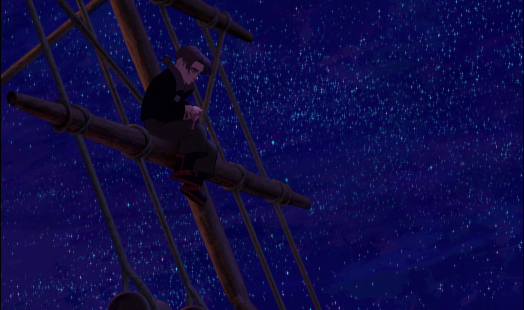
Ron Clements described the Jim Hawkins of the original Stevenson novel as “a very smart, very capable kid,” but while they wanted to retain these characteristics in their interpretation of him, they also wanted to make him “a little troubled kid” who “doesn’t really know who he is”. One of the scriptwriters, Terry Rossio, later commented that he felt the decision to age Jim up was a mistake which might have explained the film’s poor reception with audiences. He said, “Treasure Island, the book, is a boy’s adventure, about a young cabin boy who matches wits with a crew of bloodthirsty pirates. All of the key scenes are made more dramatic by the fact that it’s a young kid who is in danger… Treasure Planet made the kid into a young man. Which dilutes the drama of all the situations, start to finish… Instead of being an amazing and impressive kid, he became a petulant unimpressive teen.”
“Dilutes the drama?” I’m sorry, but I couldn’t disagree more. If there’s one thing Treasure Planet has buckets of, it’s drama, with most of it coming from the intricate relationship at its core between Jim and Silver. James Pleiades Hawkins, or Jim, is a moody and obstinate young lad from the mining planet of Montressor in a futuristic galaxy where humans coexist with aliens. The product of a broken home, fifteen-year-old Jim is going off the rails, much to his mother’s despair. Struggling in school and constantly in trouble with the local authorities, he’s only a short step away from juvenile hall when the aging spacer Billy Bones suddenly comes tumbling into his life. In his final moments, Bones bequeaths Jim a mysterious spherical object which turns out to be a map to the fabled Treasure Planet, a story that Jim has been fixated by since his youth. With the enthusiastic support of family friend Dr. Doppler, Jim embarks on an adventure in which he will discover not just treasure, but new friends and a whole new identity.


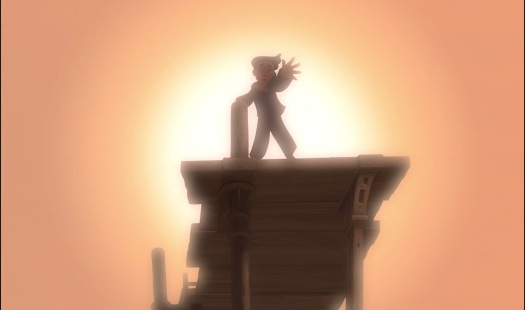
At the centre of Jim’s character is a tangle of emotional baggage related to his father’s abrupt departure in his childhood, an almost radical situation to see presented in a Disney film. Jim’s father (Leland according to the art book) is shown to be rather detached with his family even before he leaves; it’s implied that this may be due to working hard, but his son still feels lonely and disappointed. We see in flashbacks how keen he was to earn his father’s affection, or even just his attention, but was too young to realise that the problem lay with his father rather than with himself.
Now a teenager, Jim still suffers from the effects of Leland’s abandonment, acting out for attention while keeping himself closed off emotionally, even from his mother. He has a curious mind and is eager for a chance to prove himself, but doesn’t know how to go about it. After accepting the map from Billy Bones leads to the destruction of his mother’s inn, Jim, feeling responsible, embarks on the quest for Treasure Planet with Doppler as the ship’s cabin boy, determined to put things right.

During the voyage, he begins to develop a bond with the ship’s cook, John Silver. This is one of the most powerfully portrayed relationships we’ve seen thus far in the Disney canon, and that’s honestly no exaggeration. There’s a lot going on here, with Jim struggling to trust Silver even as he comes to fulfil all his needs by spending time with him, while Silver grapples with his fatherly affection for the lad as he plots a mutiny behind his back. Both characters have strong minds and initially butt heads a bit, but during a moving montage (I’m Still Here) they begin to grow closer, with Silver impressed by Jim’s skills and stamina and Jim warming up to the good-natured cook as they work together. In the following scenes, they discuss their pasts and futures, with Jim then saving Silver’s life during the supernova and Silver comforting Jim after Mr. Arrow’s death.

However, there’s a set-back. After the sinister Scroop overhears the pair in one of their bonding moments, Silver is forced to bad-mouth the lad to maintain his reputation among the other cutthroats – and Jim happens to overhear this. After all the lad’s been through, we can feel his betrayal as bitterly as if it had happened to us. He’s finally let someone get close after all these years, and now it seems that he was wrong… Silver’s just as bad as everyone else. In a tense face-off, Jim just manages to get the upper hand and runs to join the Captain and Doppler, thus sparking Silver’s mutiny.
Jim proves himself a capable shipmate throughout this incident, but more importantly, he maintains his integrity, refusing to put even his new friendship with Silver before doing what’s right. Although it clearly causes him some conflict, he snatches the map (well, sort of) out from under Silver’s nose and then stubbornly refuses to give it to him under threat. After learning that the “map” he has is actually Morph in disguise, Jim then concocts a daring plan with B.E.N. to recover the real one, returning to the ship and overcoming Scroop once and for all. Even after Silver unexpectedly shows up to steal it, Jim doesn’t waver, managing to force Silver into bringing him along on the final search for the treasure by maintaining possession of the map – this proves fortuitous, as only Jim is able to figure out how to access the treasure once they arrive.

In the cavern, Jim attempts to make off with his share of the treasure but is stopped by Silver; in one of the most uncomfortable moments in the film, it looks for a moment as though they’re actually going to have to fight each another, until they’re both thrown from the boat they’re on by a blast from a nearby thruster. Silver then faces the most difficult decision of his life; should he rescue the treasure he’s spent his entire life searching for… or his friend? Thankfully, his good nature prevails and he pulls the lad to safety in the nick of time, thus restoring Jim’s trust in him. From here on out, they’re a team again.
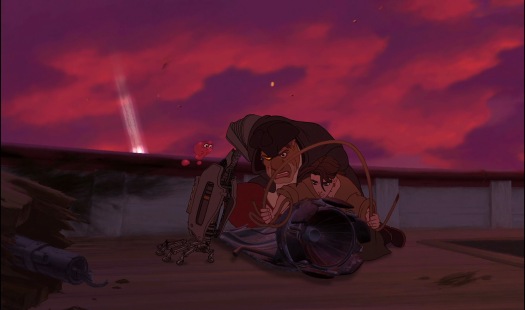
This is Jim’s moment to prove what he’s made of. With time short and the crew in danger, quick-thinking Jim cobbles together a makeshift solar surfer (with Silver’s help) and races back to the map portal to re-set it for their escape. In a tense moment, the energy in his surfer fails, but he refuses to give up and kicks it back to life in the nick of time, speeding to the portal with scarcely a second to spare and opening the gateway to safety for the ship. The crew are jubilant, but none more so than Silver, who believed in Jim from the start. In their final scene together, the two share a heartfelt goodbye as Silver hurries to escape internment, but he leaves Jim safe in the knowledge that he has a friend he can rely on. By the time the ship comes back into port, Jim has grown (physically and mentally) into a young man ready to face his future, in one of the most satisfying completions to a character arc that we’ve seen so far in the canon.
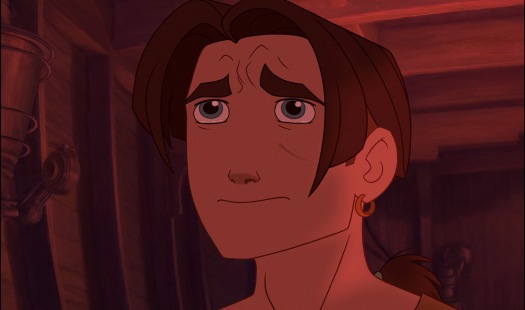
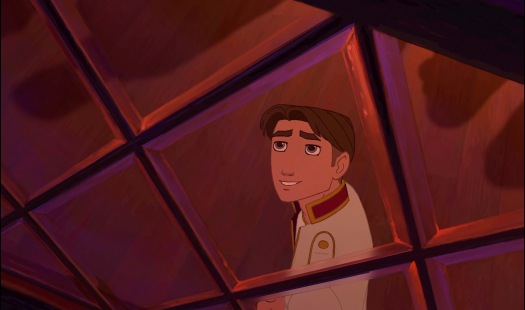
Now a member of the Interstellar Academy, we last see Jim celebrating the grand reopening of his mother’s inn with his friends, happy and comfortable in his own skin at last. He has shed his overlarge dark jacket and glowering scowl for a slick new haircut and a confident smile, but he hasn’t forgotten how he came to be this way. Although Silver is absent, Jim gazes out of the window and sees his smiling face in the clouds, continuing to watch over him with pride.
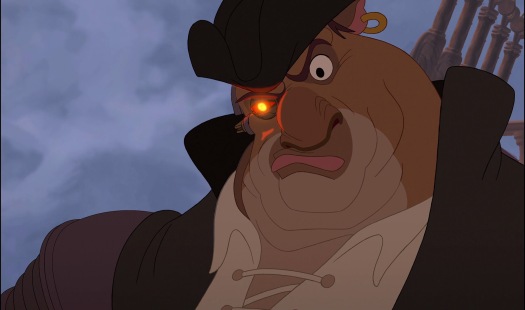

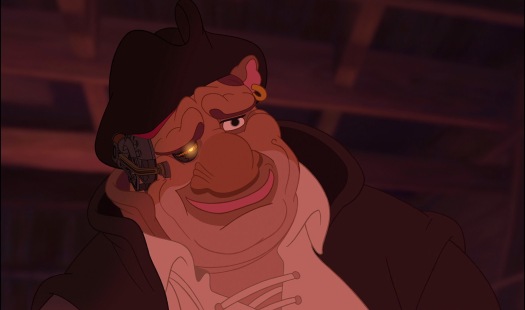
Ron Clements noted that the father-son relationship between Hawkins and Silver was present “to some degree” in the book, but they wanted to emphasise it more in the film. I’m so very glad they did, because the John Silver presented here is a more complex figure than the original one, at once shady and sinister as well as warm and paternal by turns. His character is introduced to us before he even appears on screen, in the fevered whisperings of the salty old Billy Bones, who warns Jim to “beware the cyborg” as he passes the map to Treasure Planet on to Jim. Silver and his men arrive right on Bones’ tail and promptly burn the Benbow Inn to the ground in search of the map – although they don’t find it, Silver is shrewd enough to connect it to Jim and gets himself and his gang hired by the oblivious Dr. Doppler as the crew for the RLS Legacy. Soon, they’re all heading for the elusive planet together.
As I’ve discussed above, Silver soon finds himself unexpectedly bonding with the ship’s troubled cabin boy, learning of Jim’s missing father after breaking up a scuffle between him and Scroop. Despite his hidden motives, he takes the lad under his wing and begins to discipline him for ship life, growing to respect Jim’s determination and strong-mindedness. We never learn much about Silver’s past, which leaves the way open for speculation – could he have perhaps had a family of his own, left behind in his pursuit of Treasure Planet? At any rate, it’s certainly cost him dearly already; as an amputee, he’s one of a small number of disabled Disney characters, giving us only the wistful line “You give up a few things… chasing a dream,” by way of explanation (leaving our imaginations to fill in the details).
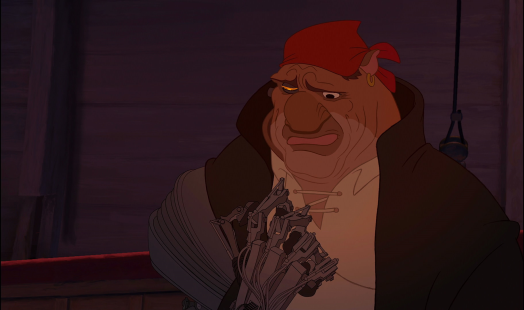
Although Silver remains committed to this dream, Jim gradually brings out his better side. He may be serving as an antagonist for much of the film, but Silver is by nature actually quite genial and jolly, enjoying a practical joke (as we see when we first meet him) and able to get along with almost anybody (except perhaps Captain Amelia). As he finds himself “gettin’ in too deep” with Jim, he finds himself morally torn, a fact which the underhanded Scroop is quick to exploit. Having seen for ourselves how genuine Silver’s affection for Jim is, it’s all the more painful to have to witness him insulting the poor kid to keep his standing at the head of the mutineers, even when we know he doesn’t mean it. However, even when he suddenly finds himself on the opposite side of the fight from his young protégée, he can’t help feeling proud of Jim’s wits and courage – in a crucial moment, he also can’t bring himself to hurt him, letting him escape with the map (well, sort of) when he could easily have shot him.
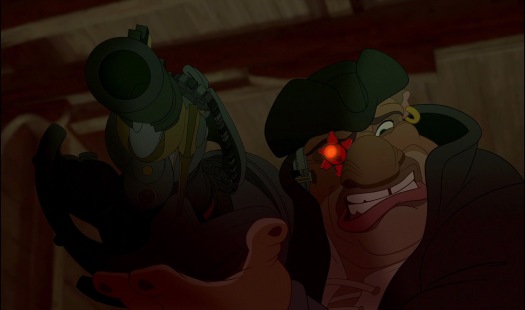
While the mutiny shows off Silver’s darker side, his internal struggle continues throughout the rest of the quest and his relationship with Jim reaches its lowest point during their “little palaver” outside B.E.N.’s hideout. Here, as Jim stubbornly refuses to forsake his Captain, Silver briefly loses patience and threatens to destroy the hideout unless Jim turns over the map, a moment which throws even Morph’s loyalty to him into question. He then stakes them out and is there to take the map when Jim returns with it, but is unable to operate it without the boy’s help and is thus forced to take him along.
Upon finally reaching the hidden treasure cavern, Silver is visibly overwhelmed. You can really feel his relief and satisfaction as he rakes up handfuls of the gold after decades of searching for it; it makes his final confrontation with Jim feel more believable. This is his darkest moment – after so much time and effort, he’s almost (almost) ready to hurt the lad to protect the treasure he feels is “owed” to him (another hint at his past – did Flint personally rob one of his ships?), but he’s saved from going down that path when the boat they’re on gets blasted, knocking both overboard. In one last mental struggle, Silver’s compassion wins out and he relinquishes his obsession in favour of rescuing Jim, proving himself one of the “good guys” at last.
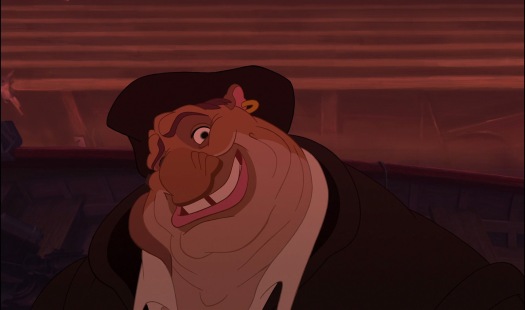
After Jim has saved the crew, nobody is prouder than Silver. The bond he and Jim share is powerful and moving after all they’ve been through and their final goodbye is a real tearjerker, as we can feel the pride and warmth radiating through the strong character animation and flawless voice acting. Silver remains consistent, the same rapscallion right to the end (he’s trying to escape imprisonment as he leaves), but he’s also gone through significant character development by his last scene – his final act is to toss the last scraps of his beloved treasure to Jim, allowing his mother to rebuild the inn which he destroyed. He might not be the most morally sound character, but it’s utterly impossible to imagine Treasure Planet without him.

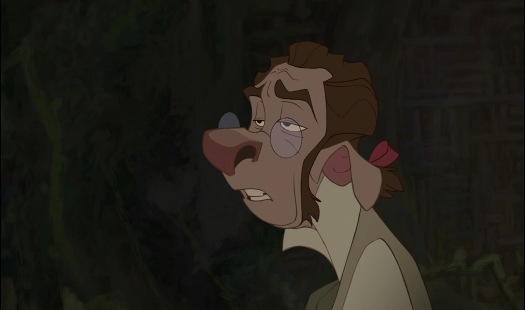

John Musker considered the two characters of Squire Trelawney and Dr. Livesey from the book to be Jim’s “mentor figures,” saying “one is more comic and the other’s very straight.” These two were fused to create the character of Dr. Delbert Doppler. He was written with David Hyde Pierce in mind for his voice, and Pierce was given a copy of the film script along with some early sketches of his character while he worked on Pixar’s A Bug’s Life (1998). He felt “the script was fantastic, the look was so compelling” and happily accepted the role.
Doppler is introduced as “an old friend of the family” by Sarah Hawkins, a “noted astrophysicist” with plenty of brains but few social skills who has a habit of blundering up most of his interactions with other characters at first. He’s a kind-hearted but rather pompous fellow who seems to serve as the most central male role model in Jim’s life, but while he means well, the two are too different to really get along well and so Jim doesn’t seem to have much to do with him. As we see from his faux pas with the police officers and then with Mr. Arrow on the Legacy, he’s rather clumsy and inept when it comes to dealing with people, although his luxurious home is a testament to his skills in other areas.
Doppler frequently plays a crucial role in the plot. It is he who finances the expedition and acts as Jim’s chaperone to allay Sarah’s fears; once the expedition is underway, he also provides vital information during the supernova incident which helps to save everyone’s lives. Later, he fills the role of doctor after Captain Amelia is injured (curiously, the crew seems to lack an officially appointed medic) and proves himself resourceful enough to escape confinement and disarm the rebels with Amelia. He’s even steers the ship while she is incapacitated, working with Jim to get everyone safely back through the portal and away from the exploding Treasure Planet. Although he demonstrates a tendency to get emotional and panic under pressure, he is always able to get through it with the support of his friends and gradually gains confidence towards the end of the adventure – much to Amelia’s delight.


Doppler’s main subplot involves his tempestuous relationship with Captain Amelia. While they initially clash due to their similarly sharp and independent natures, their fraught connection mellows into something warmer over the course of the film as they realise what a great team they make. Doppler is initially frustrated and embarrassed by Amelia’s easy social graces, but as he comes into his own and begins to take charge, the two develop a sense of equality between themselves and wind up working together to overcome the pirates and escape from Treasure Planet. While it is perhaps a bit of a leap to see them married with children at the film’s end, it’s still nice to see the once lonely Doppler relaxed and comfortable with a family of his own.
(As a side note, their relationship also affected his species; Doppler was originally planned to be human before the filmmakers devised his doglike species to compliment Amelia’s catlike one).
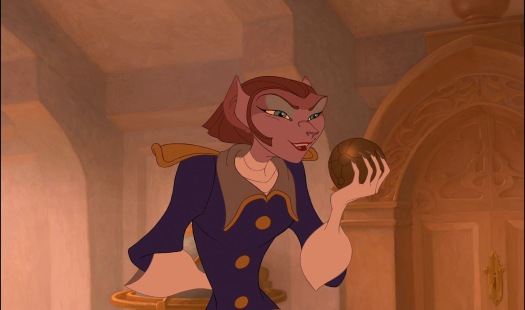

The character of Captain Amelia, based on Captain Alexander Smollet from the original, was developed with the idea of casting Emma Thompson. “We offered it to her and she was really excited,” said Clements. Musker added, “This is the first action adventure character that Emma has ever played and she was pregnant during several of the sessions. She was happy that she could do all this action and not have to train for the part.”
God, I love Captain Amelia. Sharp as a tack and hilariously witty, she serves as the no-nonsense head of the crew of the RLS Legacy during its expedition to Treasure Planet. She runs a very tight ship and takes no “flimflammery” from anybody, not even the financier of the voyage, telling Doppler in no uncertain terms exactly what she thinks of the crew he’s hired. True to her feline nature, she’s playful and rather sarcastic at times, toying with Doppler in my favourite scene of the film as she gives him a clever dressing-down, but she’s also a skilled spacer and always keeps a cool head in a crisis, no matter the risks. I don’t want to make too much of it, but I’d just like to applaud the filmmakers for choosing to make the Captain a female character here – it was a change they didn’t have to make, but they did, and I respect them for it. It’s very refreshing to see a female character in a position of authority like this; what’s more, none of the male crewmembers, even the villains like Scroop, ever try to use her gender against her. She has their respect, and that’s what counts.
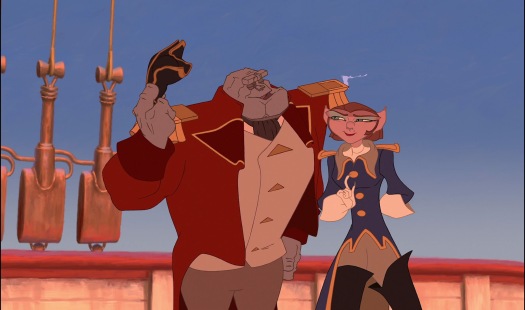
Amelia is aided by her capable first mate, Mr. Arrow, a stern-looking rock-like alien. The friendship between the two is evident from their first appearance together; they make a strong team and treat each other with a warm respect, with their (platonic) chemistry suggesting a long history of working together. After Mr. Arrow’s death (or murder, depending on how you look at it), she is visibly distraught, but even under these horrific conditions she keeps her composure and her professionalism intact, further strengthening her standing with the rest of the crewmembers.

Scroop frames Jim for the incident and it clearly wounds the lad to think that he’s hurt the Captain, as she had earned even his grudging respect with her efficient manner. Still, she seems to forgive him over the course of the film and by the end, after his daring and “unorthodox” rescue of the crew from the exploding planet, she is pleased enough with his performance to recommend him to the Interstellar Academy, thus securing a better future for him.
Amelia’s relationship with Doppler is nicely handled, with Amelia running rings around him in their first meeting (she might even be said to be flirting). Despite her good-natured teasing, she is shown to be fond of him from the start and isn’t too proud to rely on his advice when needed, such as during the supernova. Later, after getting injured in the fight with the pirates, we see a softer side of her as she reluctantly gives herself over to Doppler’s care; the two bond and end the film as firm friends, which apparently blossoms into full-fledged romance sometime before the epilogue as they have four children by that point. (Although in a mildly icky note, the filmmakers have confirmed that it wasn’t Amelia who gave birth to them… I guess that explains how she kept her figure!)
Valiant and commanding, Amelia has a strong presence throughout the film and is yet another excellent addition to an already exceptional cast of characters.
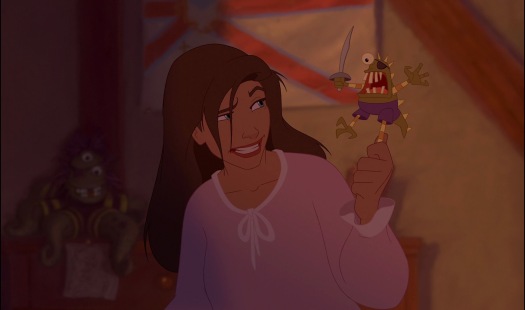

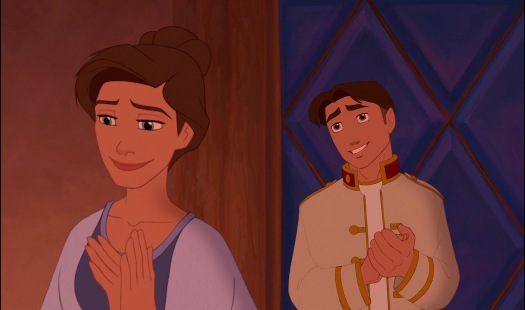
Sarah Hawkins is Jim’s loving mother, and the only other significant female character in the film after Amelia (the two never speak, unfortunately). She is also the proprietor of the Benbow Inn on Montressor which she has apparently been running single-handedly since her husband’s departure, an admirable feat, especially while trying to raise a felon… ahem, fellow like Jim. Although she has been doing everything she can, Sarah has struggled to cope with Jim’s rebelliousness and now, as he faces juvenile hall, she’s at a loss as to how to deal with him.
One night, she and Jim lose the Benbow in a savage pirate raid, leaving them homeless and with no means of providing for themselves. Taken in by the kindly Doppler, she is at her lowest moment – and then her only son suggests that he take a dangerous expedition to the other side of the galaxy! Naturally, Sarah’s worried about this, but she realises that this might be just what Jim needs to find himself and settle down, so with Doppler’s reassurance that he will look out for the lad, she consents.
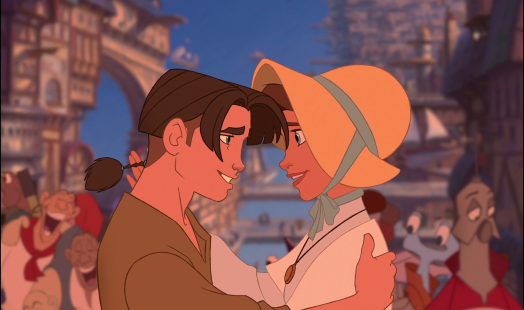
A long time later, we see Sarah again on the day of her son’s return, anxiously making her way through the crowded port in search of him. When he finds her, she’s amazed – in the time he’s been away, he’s grown as tall as she is, becoming a young man with a confidence she hasn’t seen in him since his childhood. He’s also brought back ample funds to rebuild her inn, which they reopen together shortly thereafter. At the close of the film, Sarah’s fears for her son have been well and truly put to rest; now the proud mother of a graduate of the Interstellar Academy, she can finally relax and enjoy her renewed bond with Jim in peace.
Sarah may only be a minor character, but I love the way she’s portrayed. It’s inspiring to see the way she picks herself up and carries on after her husband’s departure, proving that she doesn’t need him and can make a living for herself and her son. While Jim’s emotional problems might have been difficult to deal with at times, she’s still done a fine job of raising him into a kind-hearted and resourceful young man – in a canon dominated by orphans and motherless protagonists, Sarah is a welcome change.
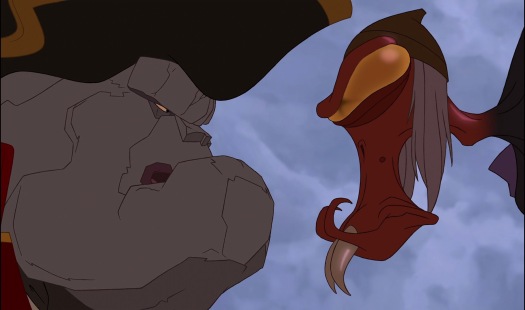

Mr. Arrow is Captain Amelia’s stoic and dependable first mate. He is a stern and vigilant officer, adept at keeping the unruly crew under control and able to give even the most stubborn cabin-boy as good as he gets. Judging from the fervent way he defends Amelia when Doppler and Jim are disgruntled with her, Arrow clearly feels a lot of respect and admiration for his Captain and has presumably been working with her for a long time. Even when her decisions don’t make immediate sense, he follows her orders without hesitation at all times, trusting her judgement wholly and completely.
Sadly, Arrow only gets to play a relatively small part in the film thanks to the evil machinations of Scroop, whom he suspects to be treacherous long before Amelia does. After publicly shaming the renegade for “brawling” with Jim, Scroop gets his revenge during the supernova incident by cutting Arrow’s life-line, effectively murdering him in a horrific way by sending him into a black hole, where he would have been torn painfully apart.
It’s a crushing blow, particularly for his friend Amelia. Arrow’s role may only be brief, but he’s a loyal first mate who puts the safety of his crew above all else and his death leaves a real hole, causing Jim a great deal of grief after Scroop makes him think he’s responsible.


Scroop, one of Jim’s fellow crewmates, is the true antagonist of the film. A dangerous-looking spiderlike creature, he is in cahoots with Silver (who plainly dislikes him even so) and joins him at the head of the mutiny after it breaks out, but prior to this, he also intimidates Jim and clashes with first mate Mr. Arrow. Scroop is malicious, greedy and sadistic, essentially a depraved nutcase with no good side to speak of – it’s actually kind of disappointing that his personality isn’t better developed, as it really shows in this otherwise excellent cast. Clearly, he was made more overtly evil to provide a better contrast with Silver, who must eventually prove himself to be good.
There seems to be a lot of bitterness on Scroop’s part; he doesn’t take well to insults and has a terrible temper, hinting at a rough life as an outlaw – his grey hair attests to the fact that he may have been in this piracy game for quite a while now. He’s a true cutthroat, with nothing, even cold-blooded murder, beyond his capabilities; the nasty moment where he cuts Mr. Arrow’s life-line is one of the most sinister acts we’ve seen from a Disney villain since Clayton shot Kerchak, at least.
It is thus a huge relief when he finally gets his comeuppance. After arriving at Treasure Planet and running into Jim on board the Legacy, Scroop enters a final faceoff with the lad which results in his demise as B.E.N. turns the gravity off; Jim dodges Scroop’s final lunge, and the awful alien is sent spinning off into the depths of space in a fitting echo of what he did to Arrow.

Now for the comic relief! We have two comic characters on offer here; the better one is Morph, who functions as a sort of “Jiminy Cricket” to Silver (as well as being a creative take on the traditional “parrot”). Morph was apparently rescued by Silver from another planet long ago and the two have been firm friends ever since, with the little globular alien acting as a kind of conscience to the morally ambiguous pirate. His role is mostly for laughs as he shapeshifts repeatedly into all manner of wacky forms (including members of the crew, like Jim and Amelia), but there are two moments where even he gets a little emotional tension.
The first and most important one comes during the mutiny, where he suddenly finds himself caught between his two friends, Jim and Silver, as they both beckon him urgently for the map he’s holding in his mouth. Unable to choose one over the other, he hides in a coil of rope – Jim gets there first and retrieves what he thinks is the map, but once on the planet below, Morph gleefully reveals himself in another of his tricks. Jim has taken only the little shapeshifter, leaving the real map behind on the ship. In the end, this proves to work out for the better, as Jim is able to use the opportunity to get rid of Scroop (which Morph also helps with by messing up the villain’s ambush).
Later, at the film’s climax, Morph then faces the same choice again, except with more tenderness. With Silver about to depart to who knows where, the kindly pirate decides (with tangible grief) to pass the little alien on to Jim for safekeeping, with tears on both sides. It’s a sweet moment, wrapping up Morph’s little subplot of getting caught between warring friends nicely.
Innocent and childlike, Morph brings a sense of freshness to an emotionally heavy film, largely succeeding in his purpose as comic relief. That’s more than can be said for…

Oh poo… they were doing so well. Jim meets the “Bio-Electronic Navigator”, or B.E.N. at the start of the film’s last act just after he arrives on Treasure Planet, and from that point onwards there’s this constant, grating noise in the background of almost every scene as Martin Short rambles on and on in a screeching voice – I’m sorry if you like him, but B.E.N. is the pinnacle of annoying. I don’t think I’ve hated a “comic” character this much since Creeper in The Black Cauldron! (Even the Gargoyles were better than this).
One of the most unpleasant things about this character is that most of the “comedy” is being derived from his poor memory, which when you think about it isn’t really something we should be finding funny. B.E.N is a rather tragic figure really; I’d feel sorry for him if he wasn’t so darn irritating. Created by deceased pirate crime boss Nathaniel Flint, one of Flint’s last acts before his death was to viciously tear out the robot’s primary memory circuit, leaving him with a form of electronic short-term memory loss, stranded on Treasure Planet and barely able to remember his own name.
Once Jim arrives, B.E.N., obviously very lonely, latches on to him and tries to “help” with his quest (in his own inept way), providing the group with shelter at his home and accompanying Jim back to the ship to recover the map. After unintentionally helping the lad to defeat Scroop and disabling the ship’s cannons, he then tags along as Jim heads into the treasure cavern with the pirates and has his memory restored when they stumble across Flint’s skeleton, still clutching B.E.N.’s primary memory circuit. At this point, he warns of the booby trap Flint rigged to prevent anyone stealing his treasure and continues to provide precise updates on the situation as things worsen. This is about as far as his contribution goes; he also dances “the robot” at the reopening party for the Benbow in a rather silly visual gag, but that’s about it.
I don’t know what was needed to fix this character – better writing, or a different voice actor, perhaps? Whatever the case, we have to take him as we find him – and I find him exasperating to the highest degree.
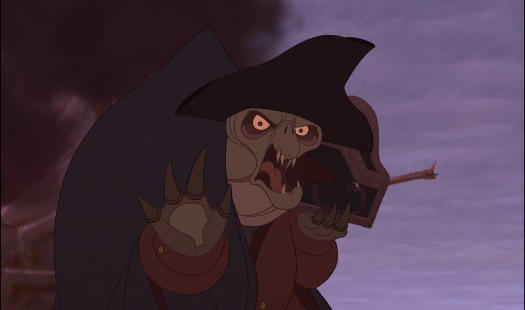
The last named character with a significant role is Billy Bones, the old spacer who literally crashed into Jim’s life near the start of the film and delivers the map of the galaxy into his hands. According to the film’s art book, he’s over one hundred years old and served as Captain Flint’s cabin boy (meaning he must also know B.E.N.); the wounds that finally kill him were sustained in a final battle with Silver for the map. Patrick McGoohan had a cold when he voiced the role, something the directors made use of as they needed the character to sound like he was “on his last legs” anyway, according to Musker. (He joked that there weren’t as sympathetic as they could have been, encouraging the actor to phlegm up his performance as much as possible).
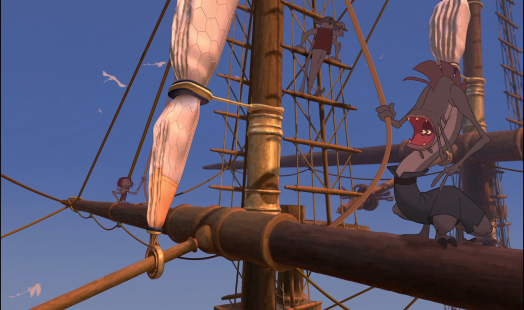

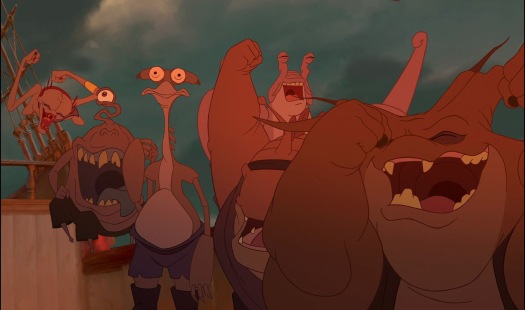


The rest of the crew of the RLS Legacy consists of a staggering fourteen named characters, but thankfully they’re not given much attention and so we don’t have to spend too much time on them. However, confusingly, most of them have at least two different names depending on which source you’re consulting; for clarity, I’ll use the names they go by in the art book, with the names used in online sources in brackets.
First, there are Scroop’s fellow riggers: Mackriki (Longbourne) is the slimy-looking one with eyes in his throat, Oxy and Moron (or Hedley and Torrence) are the head-and-body pair who call Jim a weirdo, Greedy (Verne) is the small one with suction cup hands, Dogbreath (Fayvoon) is the dopey-looking Jar-Jar one and Birdbrain Mary (Krailoni) is the sole female pirate who looks like a walking brain.
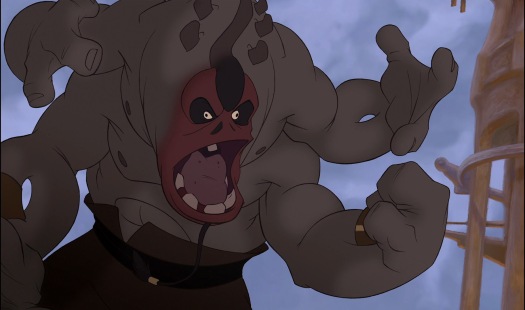
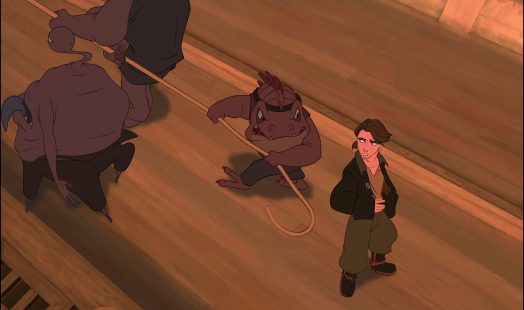
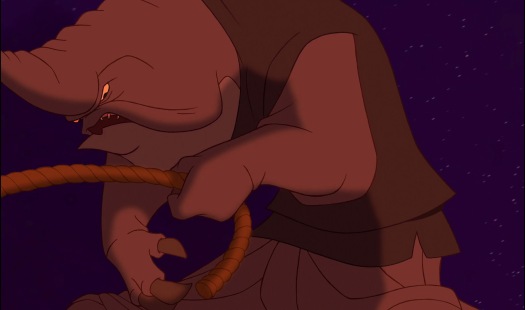
Then we have the ropers: Hands (one of the few with a consistent name), the huge multi-armed creature who calls Jim a twerp, Pigors (Blinko), the one-eyed big-mouthed one, Aquanoggin, the vaguely fish-shaped one, and Schwartzkopf (Mertock), the one with the large horn in the centre of his forehead.


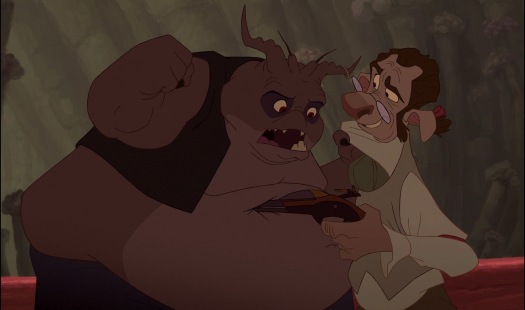
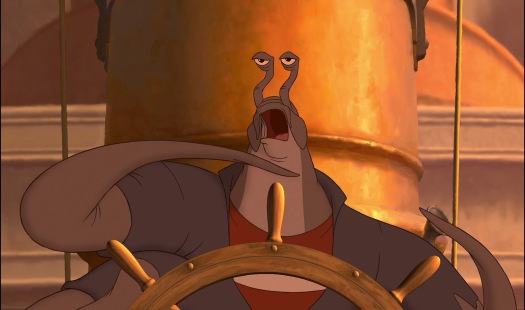
Finally, there are the four specialists: Snuff, the slug-like engineer who speaks “Flatula,” Onus, the multi-eyed lookout, Meltdown (Grewnge), the obese gunner, and Turnbuckle, the squid-like helmsman.
Heaven knows where they got those names from, or why most of the characters seem to have more than one – could some of these be aliases used by the bandits when they’re “on a job”? Most likely the characters were simply too minor for Disney to worry about consistency; after all, only pedantic critics like me would ever take the trouble to look up their names in the first place! Honestly, the things I do for accuracy.
Needless to say, most of the pirates aren’t fleshed out much or even referred to by name on screen. Onus, Snuff and Turnbuckle get the most attention, and Hands, Oxy, Moron, Meltdown and Birdbrain Mary all get the odd line, but otherwise the pirates function as a collective. They’re the muscle, the brute force Silver uses to overcome the Captain and her remaining crew. Pigors and Turnbuckle are killed when they fall into the fiery chasm at the heart of Treasure Planet, while Hands, Longbourne and Dogbreath all fall out of the ship’s hold during the mutiny and are presumably killed on impact. Greedy is electrocuted during the mutiny and isn’t seen again, so he presumably died too. Once they reach the planet, Snuff, Aquanoggin and Schwartzkopf all mysteriously vanish (perhaps mutinying from the mutineers), with the remaining five pirates (Oxy, Moron, Mary, Meltdown and Onus) all being arrested by Amelia and taken home to be imprisoned.
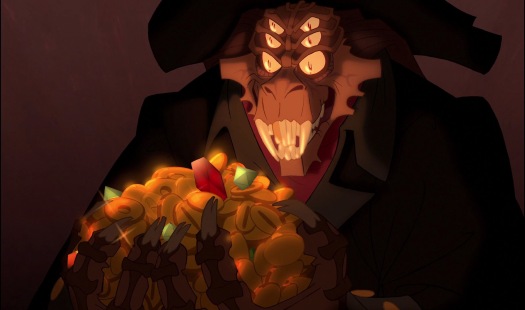

Captain Nathaniel Flint is only seen briefly in Jim’s holobook, robbing and pillaging a merchant ship and chuckling evilly over his loot. He has a pretty commanding presence for such a minor character, though, casting a pall over much of the rest of the film as the other characters search greedily for his stash. Two, Billy Bones and B.E.N., actually knew him in life, with the latter rambling on conversationally about his “mood swings,” but other than that we don’t learn much about him. We see Flint himself (or what’s left of him) once they finally get inside Treasure Planet – the spacer’s skeleton is still there, jealously guarding his hoard for the rest of eternity.

At the start of the film, we meet a pair of robotic police officers who apprehend Jim during his latest jaunt on his illegal solar surfer. They’re clearly familiar; Jim is even able to finish one of their sentences when the cop struggles for a moment to think of the exact paragraph of the law that Jim has violated. They don’t have a particularly supportive attitude towards the little delinquent and even backhandedly call him a “loser” in front of the entire pub, before cheerfully taking their leave. Of course, like all good brown-nosers, they soon change their tune when Jim returns home as a distinguished spacer; the last time we see them is as his escorts, when he arrives at the reopening party.

I’m going to wrap up this incredibly long section with a brief mention of Mrs. Dunwoody, the only named customer at the Benbow Inn near the film’s start. She is a matronly and rather demanding female alien whose only role is basically to emphasise how stressful Sarah’s job is, as well as mocking needy customers who don’t treat servers with respect (I know what that feels like). The only reason I mention her is because, as a named female character who engages in limited conversation with Sarah Hawkins, her presence allows this film to pass the Bechdel test by a slim margin. While the test isn’t infallible, it’s designed to highlight the lack of representation of women in film, and while I do love Treasure Planet, I do find it a shame that it has only two significant female roles in it.
Animation
The animation supervisors on Treasure Planet were John Ripa for Jim, Glen Keane for Silver, Ken Duncan for both Amelia and Scroop, Sergio Pablos for Doppler, Oskar Urretabizkaia for B.E.N., Michael Show for Morph, Jared Beckstrand for Sarah, T. Daniel Hofstedt for Arrow, Nancy Beiman for Billy Bones, Brian Ferguson for Onus, Marc Smith for Hands, Adam Dykstra and Ellen Woodbury for the rest of Silver’s crew and John Pomeroy for Captain Flint and his crew.
Much like Joseph Gordon-Levitt and Brian Murray, Keane and Ripa worked closely together while animating Silver and Jim to help them get across the bond between the characters more effectively. John Musker mused that the fusion of traditional and computer animation used to create Silver and his prosthetics could be taken as symbolic of the wider traditional vs. computer debate, which was just starting to gather steam at the time; it’s worth noting that Silver’s warmer, traditionally-animated “human” side eventually triumphs over his cold, greedy “mechanical” side in the end.
Keane stated specifically that he tried to avoid looking at previous portrayals of a character to “clear his mind of stereotypes,” but he did draw some inspiration for the way Silver speaks from actor Wallace Beery, who he loved “because of the way he talked out of the side of his mouth”. Meanwhile, John Ripa cited fifties icon James Dean as a key reference in his design of Jim, because “there was a whole attitude, a posture” wherein “you felt the pain and the youthful innocence,” as well as the film Braveheart (1995), where “there are a lot of close-ups on characters… who are going through thought processes, just using their eyes.”
For reference, the animators created maquettes – small statues of the characters – which they could keep on hand while they worked. Sculptor Kent Melton noted that this technique had been used as far back as Pinocchio (1940), but this was the first Disney film in which the maquettes were not entirely handmade out of clay; Silver’s cyborg parts were made of plastic, using laser technology. In a rather funny note, to test the meshing of the computer-animated cybernetics with Silver’s traditionally-animated body, the animators created a practice run using old footage of Captain Hook from Peter Pan (1953), replacing his whole arm with Silver’s robotic one (this can be seen as an extra on the DVD).

In addition to the usual traditional and computer animation techniques, the artists here also made extensive use of the Deep Canvas technology first used in Tarzan, coming up with a process they called “Virtual Sets” where they created each 3D set in full before staging scenes in them. These sets, combined with the traditionally-animated characters, created the effect of a “painted image with depth perception” and enabled the crew to experiment with more creative camera movements than the Pinocchio team could have ever dreamed of.
So, how well do all these different techniques work together? Very well, I’d say. This film looks great from start to finish, an innovative blend of different techniques all playing off one another beautifully. (The only really dated part are the rather plastic-looking CGI Orcus Galactici which spray Doppler just after take-off). The scale of the environments and the details in the character work are fantastic, showcasing the artists’ talents and dedication. B.E.N.’s animation was created in computers first, then translated into line drawings which were then inked and painted traditionally to better blend him in with the other characters. For Morph, Michael Show studied old news footage from the Apollo missions, basing the alien’s movements on the way water globules moved in zero gravity. To prepare for animating Silver’s robotic arm, meanwhile, Keane and his team went to a local Benihana restaurant to observe a real chef chopping shrimp as Silver would be required to do.
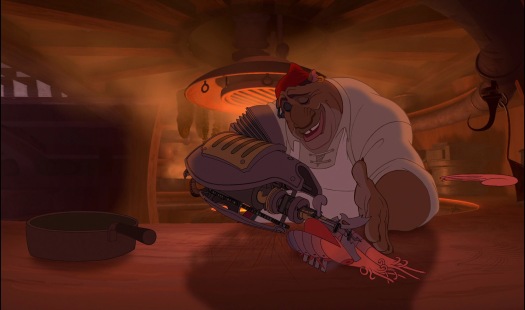
As usual, the directors also made a brief cameo appearance. When Jim and Doppler first arrive at the spaceport Crescentia, they ask for directions from two nondescript aliens working with a ladder; these are caricatures of Musker (top of the ladder) and Clements (holding the bottom) respectively.
It’s such a shame animating this way proved to be so expensive; I would have liked to have seen more films done in this style, as it might have provided a way for computer animation and traditional animation to coexist.
Plot
One of the film’s writers, Rob Edwards, noted that “it was extremely challenging” to move the classic adventure novel to outer space, with the team doing away with many typical sci-fi elements early on (“things like the metal space ships and the coldness”). He also explained that they “did a lot of things to make the film more modern” and that the reason for setting the film in outer space was to “make the story as exciting for kids now as the book was for kids then”.

It’s certainly an unusual take on the tale, but the move to space wasn’t the only change made during production. The film’s prologue was originally going to be narrated by an adult Jim, who would tell the story of Captain Flint in the first person, but the crew later felt this was too “dark” and lacked character involvement, so they replaced it with the holobook version narrated by the late, great Tony Jay in his final role for Disney. This gave Jim a more personal connection to the Treasure Planet legend early on and provided him with the motivation to find it as a teenager. There was also a scene planned in which Jim would be seen constructing his solar surfer while chatting to an alien child, demonstrating a more “sensitive side” as well as serving as a homage to The Catcher in the Rye, but the planned scene of Jim actually using the solar surfer rendered this unnecessary, so it was cut.
This version of the story focuses much more on the characters’ relationships than the original did and I think this works to its advantage; it adds depth and makes the characters more engaging, without detracting from the adventure of the story itself. I only read the Stevenson original once (when I was about Jim’s age, funnily enough) and I don’t remember it leaving much of an impression, so personally I’d say I connect to this version much more. It’s easy to get invested in Jim’s journey from a troubled bad boy to a grounded young man, not to mention Silver’s gradual transformation from a grizzled old scallywag to a caring friend. This is a very character-driven story, but the MacGuffin of Treasure Planet remains sufficiently alluring to keep the pace going as well.
Of course, it isn’t perfect. I can accept the explanation of the “Etherium” giving this version of outer space a breathable atmosphere, but the writers took considerable creative license with physics at times that made certain scenes (particularly the big supernova showpiece) feel a little flat. It just about works due to “Rule of Cool,” but you have to stretch your suspension of disbelief pretty far at times if you know anything about how black holes actually work.
Cinematography
The art direction for the film was handled by Andy Gaskill, with Dan Cooper as head of backgrounds. They created a unique vision of outer space influenced by the world of steampunk, a combination of old-fashioned technology with futuristic elements. In order to make the film more “fun” in the action sequences and to avoid being bogged down with space suits and other paraphernalia, the crew created the concept of the “Etherium,” an “outer space filled with atmosphere.” This version of the film may also have drawn a little inspiration from Disney’s previous adaptation, the live-action version from 1950 – that was the first fully live-action film Disney ever produced as well as the first adaptation of Treasure Island filmed in colour.


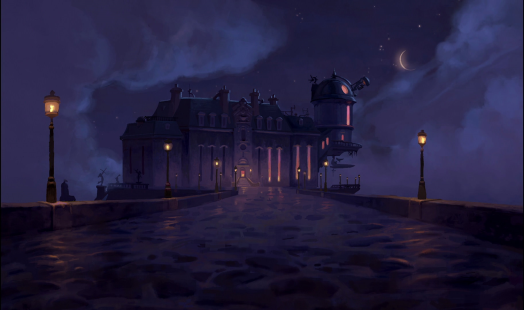
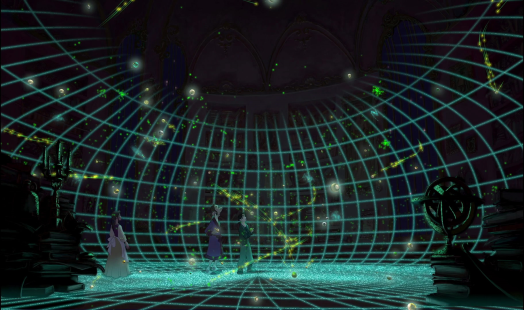
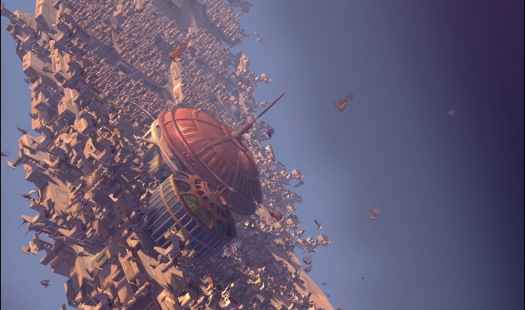

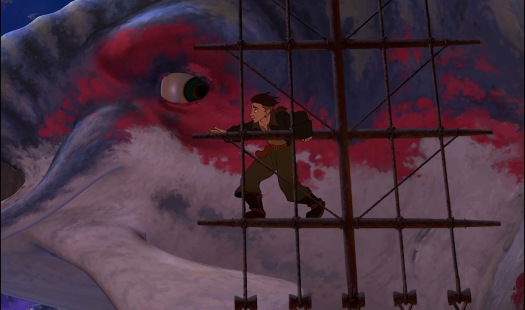







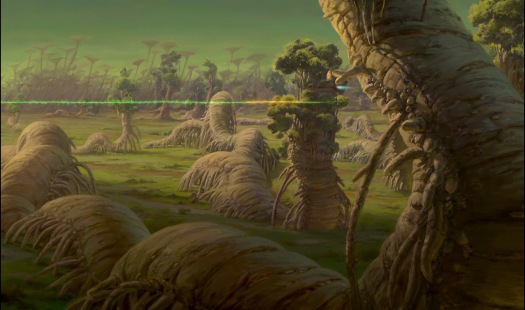
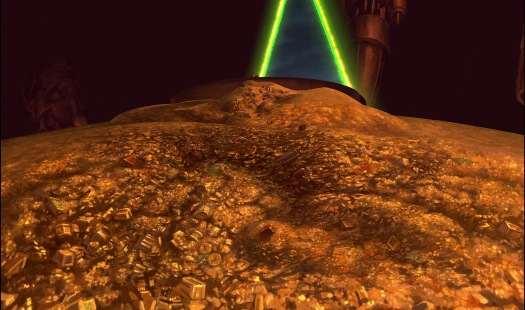

During the production of Treasure Planet, the crew followed a rule they devised called the “70/30 Law” (which Gaskill attributed to Clements). This was a rough guide to help them balance the steampunk elements; 70% would be traditional technology, the other 30% would be sci-fi. To prepare, the team researched old European architecture, military uniforms and Spanish and English galleons, with the Crescentia Spaceport being based loosely on the British town of Bristol.
Artistically, the filmmakers were largely inspired by the art style promoted by a group of illustrators associated with the famed Brandywine School of Illustration (including Howard Pyle and N.C. Wyeth), which they cited as examples of “classic storybook illustration” with a painterly feel to their works and warm colour palettes. The style blended traditional painting techniques with more modern, Impressionistic styles, which was exactly the sort of effect the Treasure Planet team were going for with their combination of new and old settings and animation techniques. They wanted a warmer, more organic version of outer space than in earlier sci-fi works.
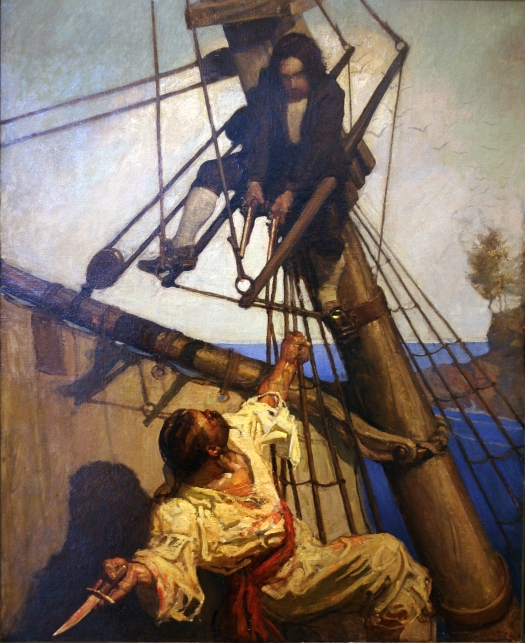

Among the film’s various panoramas and scenic shots, one of my favourites was the slow pan and zoom into the Crescentia Spaceport, in which the camera flies through Doppler’s window to slowly focus on the port before diving down among its buildings and workers. It’s a clever shot, in which the half-moon shaped port is slowly revealed in all its detail, and time passes during it because it comes to rest on Doppler and Jim disembarking there, presumably several weeks after the conversation the shot began on. Aside from this, the other highlights of the cinematography include the sequence of the star Pellucid going supernova, which is played dramatically with dazzling spectacle, and of course the arrival at Treasure Planet itself. I also really like the last shot of the film, in which we see Silver’s smiling face in the clouds, symbolically watching over Jim as the credits roll.
Soundtrack
The “70/30 Law” was also used on the sound and music of the film. Dane Davis, the sound designer, described how his team “scoured hobby shops and junk stores for antique windup toys and old spinning mechanisms” to try to create the right sound effects for Silver without “sounding slick or sci-fi.” His team experimented with working sound effects into certain characters’ dialogue, particularly B.E.N., but in the end they decided to stick with Martin Short’s natural voice because their additions always “affected his comedy” and “the last thing you want to do in a story like this is affect performances”. Hmmm…
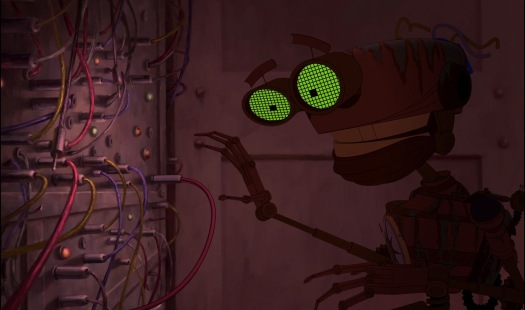
For the score, Alan Silvestri was originally brought on board, but then he left to work on Disney’s other work of 2002, Lilo & Stitch. To replace him, Disney thus hired James Newton Howard for his third and, to date, final score for the studio, mainly because he was famous for working quickly, conducting and recording all of his previous scores in less than five months. (I’m curious to find out more about this; did Silvestri leave at the last minute, I wonder? What happened?)
Howard said that the score was “very much in the wonderful tradition of Korngold and Tiomkin and Steiner”, while other critics have described it as a mixture of modern “classical style” music in the spirit of Star Wars and Celtic music. Scottish fiddler Alasdair Fraser was credited as co-composer on the track “Silver Leaves” and is also listed in the film’s credits as featured soloist. (His work can be heard in several of the film’s more thoughtful moments, it’s really beautiful). As always, Howard’s score here is outstanding – perhaps not quite as powerful as Dinosaur’s, but still up there as a personal favourite.
The film also features two original songs, written and performed by the frontman of The Goo Goo Dolls, John Rzeznik. Rzeznik was suggested to the directors by artist Glen Keane and they readily agreed, approaching Rzeznik themselves; he was reportedly just as excited to work with them as they were with him.





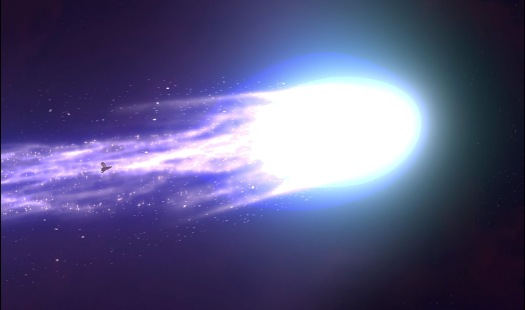
The first song (and the only one to play in the film itself) is I’m Still Here, which has been dubbed by fans as “Jim’s theme”. This has become a huge fan favourite, going to some darker places than typical Disney fare – it’s an angsty pop-rock number performed with raw energy by Rzeznik, in which we learn more about Jim’s troubled past and the scars he carries. His disappointment with his father is contrasted with his budding relationship with Silver and the song concludes on a positive note, with the two of them settling down for a chat after a long day. It’s a strong number, making me wish that there could have been more songs of this quality in the film – but then perhaps turning it into a musical would have hindered rather than helped it.

The second song, playing over the end credits, is Always Know Where You Are, which I chose as my twenty-third favourite credits song in an earlier post. It’s a triumphant end to Jim’s story and really fits the gritty, defiant tone of the film; once again, it’s almost jarringly different from Disney’s usual Broadway-inspired style. Although Rzeznik performs once again for the film, the song was covered for the soundtrack by British pop-rock group, BBMak.
The writing for this film is generally excellent, for the same reasons as Lilo & Stitch; the character relationships presented here are done with a subtle realism which is bound to ring true with many viewers who have experienced similar relationships themselves. The writers did a good job, I think, of balancing the story’s adventurous elements and pacing with the delicate character dynamics between Jim and Silver.
Of course, good writing is nothing without strong voice performances, which thankfully this film also has plenty of. Joseph Gordon-Levitt and David Hyde Pierce both deliver solid performances, but Brian Murray and Emma Thompson are the highlights; their characters only share a couple of brief exchanges, but they’re great comic moments. Brian Murray affects a warm, lilting brogue for Silver which gives him a whole new layer of charm, and his scenes with young Gordon-Levitt are very affecting. Even when Silver is being a bit of a brute, Murray somehow keeps him likeable. Then there’s Thompson’s Captain Amelia; I can’t get enough of this character. She gets an entire scene of witty one-liners with David Hyde Pierce’s Doppler, which I enjoy enough to quote here:
Amelia: “Doctor. To muse and blabber about a treasure map, in front of this particular crew, demonstrates a level of ineptitude, that borders on the imbecilic – and I mean that in a very caring way.”
{Later}
Amelia: “Let me make this as… monosyllabic as possible. I don’t much care for this crew you hired. They’re… how did I describe them, Arrow? I said something rather good this morning before coffee.”
Arrow: “A ludicrous parcel of drivelling galoots, ma’am.”
Amelia: “There ya go; poetry!”
Doppler: “Now see here -!”
Amelia: “Doctor, I’d love to chat, tea, cakes, the whole shebang, but I’ve got a ship to launch and… you’ve got your outfit to buff up.”
Final Verdict –
In the run-up to its release, Treasure Planet had promotional deals with McDonald’s, Pepsi-Cola, Dreyer’s and the Kellogg Company. McDonald’s included toys and puzzles in their Happy Meals, while Pepsi-Cola put promotional film graphics onto several of their soft drinks. Dreyer’s promoted ice-cream flavours inspired by the film (“Galactic Chocolate” and “Vanilla Treasure”) on their delivery trucks and Kellogg used film-branded spoons in their cereal boxes. Hasbro were also involved; they released a line-up of themed action figures and toys.
The film was touted as “the first major studio feature” to be released in both regular and IMAX theatres simultaneously; this was done because of the success Disney had had with several other IMAX re-releases, such as Fantasia 2000 and Beauty and the Beast. Dick Cook, who was then the chairman of Disney’s Entertainment branch, mentioned that the dual release was a way to distinguish themselves during the competitive holiday season.
Unfortunately, things didn’t turn out well at all for Treasure Planet. It suffered from a lot of competition, especially from the second instalment of the hugely popular Harry Potter franchise, Chamber of Secrets. It was also compared unfavourably with Don Bluth’s final film, Titan A.E., which had been released two years previously to such disappointing box office that it sank Fox’s animation studio and Bluth’s career in one go. The film featured a similar sci-fi setting and mature themes, and ironically, part of the reason for its failure was that it was rushed to completion in order to beat Treasure Planet to theatres.
As for Treasure Planet itself, it became the worst bomb in Disney history; the unusually high budget coupled with poor marketing essentially crippled it and it made a paltry $38 million domestically against a whopping $140 million budget. Even with international earnings factored in, it wound up at just $109 million, costing the studio dearly. Not even The Black Cauldron had been this bad (although the studio had been in a weaker position at that time). Critics were divided on the film, with Roger Ebert among the most notable to dislike it, but audiences were rather kinder to it and it has steadily built a better reputation among fans over the years since. Despite the financial loss, it is now generally regarded as a cult classic.
Before the film was released, the president of Feature Animation at the time – Thomas Schumacher – was considering direct-to-video sequels and a spin-off TV series, which were standard for most Disney films of the time. Apparently, they even had “a story and some storyboards and concepts up and a script for a what a sequel to {Treasure Planet} could be,” and he added that there was a “notion” of what the series could be. The sequel would was being developed by Jun Falkenstein and screenwriter Evan Spiliotopoulos and would centre around Jim and his new love interest, Kate, who would team up with Silver to stop a villain named Ironbeard (voiced by Willem Dafoe) from starting a mutiny at a prison. Naturally, all this came to naught when the film bombed (perhaps that’s for the best, judging by the quality of the many other DTV sequels).
The original film was released to both VHS and DVD in early 2003, with the DVD including behind-the-scenes featurettes, a visual commentary, deleted scenes, trailers and a music video by John Rzeznik. For the film’s tenth anniversary in 2012, Disney released a new DVD/Blu-ray combo pack. (This must mean I have the original 2003 DVD).
So, once again, I must close by defending a good film which was rather badly treated by its parent company. There’s a theory going around (which I’ve linked to below) that Disney killed this film deliberately to give them an excuse to end their line of traditionally animated films, which might not be as preposterous as it sounds when you consider the state of the animation world in the early 2000s. I can only stress how important it is not to pay attention to box office figures or awards, as they’re not always indicators of a film’s quality – look to the fans, of which Treasure Planet has a considerable number. This film was made with a great deal of love and attention by two directors who’d been dreaming of creating it for more than a decade; it may not be perfect, but you can feel that passion for the project seeping through every character, every set-piece and every note of the music. Sure, B.E.N. sucks, and okay, the steampunk vibe might not be to everyone’s taste, but I don’t think anyone can deny that Treasure Planet is a very sincere film and a smashing adventure to boot. Give it a try and see for yourself – I’m sure it’ll rattle your stars.
My Rating – 5/5
References
I consulted my own books to research for this review, as well as some standard web sources:
The Art of Walt Disney (2011 ed.) by Christopher Finch
The Art of Treasure Planet (2002) by Jeff Kurtti
https://en.wikipedia.org/w/index.php?curid=3519583 – credit for poster
By Newell Convers Wyeth – This image was originally posted to Flickr as N.C. Wyeth, Public Domain, https://commons.wikimedia.org/w/index.php?curid=6037424 – credit for N.C. Wyeth image
https://www.youtube.com/watch?v=b9sycdSkngA&t=1s&index=11&list=WL – an excellent YouTube analysis of the film and the reasons for its lacklustre performance
https://en.wikipedia.org/wiki/Treasure_Planet – Wiki page
http://www.imdb.com/title/tt0133240/ – IMDB profile




I had seen all of the promotional trailers and TV spots for this film when it first came out (I was in second grade at the time), but I only first watched it around the time I started college. And believe it or not, this was my re-introduction to Stevenson’s story– I had previously been introduced to it through MUPPET TREASURE ISLAND (starring Kevin Bishop as Jim Hawkins, Tim Curry as Long John Silver, Billy Connolly as Billy Bones, Kermit the Frog as Captain Smollett, Miss Piggy as Benjamina Gunn, Fozzie Bear as Squire Trelawney, Bunsen Honeydew as Dr. Livesey, and Sam the Eagle as Mr. Arrow), which I rediscovered more recently.
Call me what you will for this opinion, but I, personally, have no problem with B.E.N., at all. I actually consider him very amusing, in his own way; and if you ask me, the voice that Martin Short gave him is nowhere near as grating as the one that Joey Mazzarino gave to Horatio the Elephant, on SESAME STREET (watch this 2005 “Global Grover” segment, and you’ll see what I mean: https://www.youtube.com/watch?v=xJvkmcyC2uo).
One interesting thing I’ve noticed about Morph is that he shares certain traits with the Pokémon known as Ditto: both are pinkish in color and gelatinous in texture, and both can shape-shift. Coincidence? I don’t think so…
LikeLiked by 1 person
Yeah, I remember actually being put off by the trailers / DVD cover at the time, I think the design of some of the aliens freaked me out haha. I’m not sure I would’ve liked it at that age anyway; I think it’s better appreciated as a teen, at least. At any rate, I read the book before I saw this (and I’ve heard of the Muppet version, never watched it but it looked interesting!)
Hm, I see what you mean, not a voice I could listen to for long! Well, to each their own – I’m glad you enjoyed B.E.N. more than me. To be fair, I don’t mind Gurgi, and most people seem to detest him.
Ah, I was always more of a Yugioh lad so I wouldn’t know, but I wouldn’t be surprised if they got a little inspiration from Pokémon, given how popular it was at the time.
LikeLike
Incredibly underrated!
LikeLiked by 1 person
Please sign this: https://www.change.org/p/to-get-disney-to-finally-give-treasure-planet-the-respect-and-attention-that-it-deserves
LikeLiked by 1 person
Signed – it does deserve more attention!
LikeLike
Thank you so much! I really appreciate that! But I would be more happy if you share the petition with others that like the movie too, because that would really help!
LikeLike